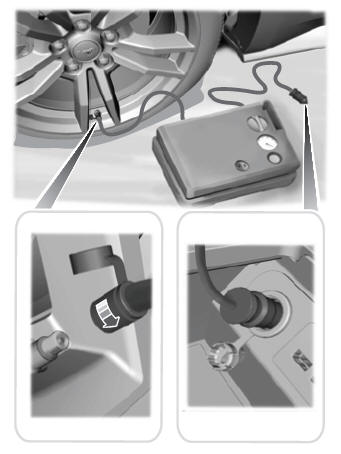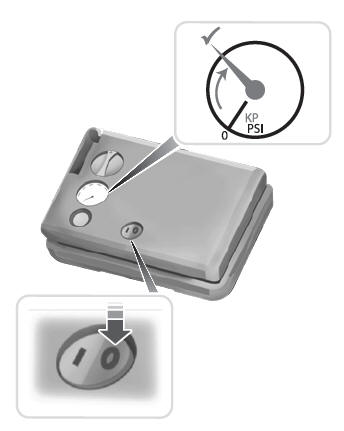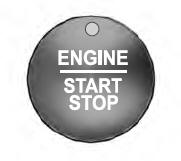Lincoln Corsair: Tire Sealant and Inflator Kit (IF EQUIPPED) / First Stage: Reinflating the Tire with Sealing Compound and Air
WARNING: Do not stand directly over the kit while inflating the tire. If you notice any unusual bulges or deformations in the tire's sidewall during inflation, stop and call roadside assistance.
WARNING: If the tire does not inflate to the recommended tire pressure within 15 minutes, stop and call roadside assistance.
WARNING: Do not run the engine when operating the air compressor unless the vehicle is outdoors or in a well-ventilated area.
Preparation: Park the vehicle in a safe, level and secure area, away from moving traffic.
Turn the hazard lights on. Apply the parking brake and turn the engine off. Inspect the flat tire for visible damage.
Sealant compound contains latex. Use appropriate precautions to avoid any allergic reactions.
Do not remove any foreign object that has pierced the tire. If a puncture is located in the tire sidewall, stop and call roadside assistance.
- Remove the valve cap from the tire valve.
- Unwrap the dual purpose hose (black tube) from the back of the compressor housing.
- Fasten the hose to the tire valve by
turning the connector clockwise. Tighten
the connection securely.

- Plug the power cable into the 12-volt power point in the vehicle.
- Remove the warning sticker found on the casing/housing and place it on the top of the instrument panel or the center of the dash.
- Start the vehicle leave the engine running
so the compressor does not drain the
vehicle’s battery.

- Turn dial (A) clockwise to the sealant position. Turn the kit on by pressing the on/off button (B).
- Inflate the tire to the pressure listed on
the tire label located on the driver's door
or the door jamb area. The initial air
pressure gauge reading may indicate a
value higher than the label pressure
while the sealing compound is being
pumped into the tire. This is normal and
should be no reason for concern. The
pressure gauge reading will indicate the
tire inflation pressure after about 30
seconds of operation. The final tire
pressure should be checked with the
compressor turned OFF in order to get
an accurate pressure reading.

- When the recommended tire pressure is reached, turn off the kit, unplug the power cable, and disconnect the hose from the tire valve. Re-install the valve cap on the tire valve and return the kit to the stowage area.
- Immediately and cautiously, drive the vehicle 4 mi (6 km) to distribute the sealant evenly inside the tire. Do not exceed 50 mph (80 km/h).
- After 4 mi (6 km), stop and check the tire pressure. See Second stage: Checking tire pressure.
Note: If you experience any unusual vibration, ride disturbance or noise while driving, reduce your speed until you can safely pull off to the side of the road to call for roadside assistance. Note: Do not proceed to the second stage of this operation.
 Tips for Use of the Kit. What to do when a Tire Is Punctured
Tips for Use of the Kit. What to do when a Tire Is Punctured
Tips for Use of the Kit
To ensure safe operation of the kit:
Read all instructions and cautions fully.
Before operating the kit, make sure your
vehicle is safely off the road and away
from moving traffic...
 Second Stage: Checking Tire Pressure
Second Stage: Checking Tire Pressure
WARNING: If the tire does not inflate
to the recommended tire pressure within
15 minutes, stop and call roadside
assistance.
WARNING: The power plug may get
hot after use and should be handled
carefully when unplugging...
Other information:
Lincoln Corsair 2020-2024 Service Manual: Description and Operation - Handles, Locks, Latches and Entry Systems - Component Location
Item Description 1 BCM 2 Exterior Front Door Handle RH 3 RTM 4 Keyless Entry Rear Antenna 5 Exterior Front Door Handle LH 6 RKE Exterior Sounder ..
Lincoln Corsair 2020-2024 Service Manual: General Procedures - Engine Noise Identification and Location
NOTE: This procedure uses multiple tools/methods to help locate the source of engine noise. It may be necessary to repeatedly compare the sound between the tools/methods to help locate the source of the noise. NVH symptoms should be identified using the diagnostic tools and techniques that are available. For a list of these techniques, tools, an explanation of their uses and a ..
Categories
- Manuals Home
- 1st Generation Lincoln Corsair Owners Manual
- 1st Generation Lincoln Corsair Service Manual
- Auto Hold (IF EQUIPPED)
- Keyless Entry Settings
- Memory Function
- New on site
- Most important about car
Keyless Starting
Note: The keyless starting system may not function if the key is close to metal objects or electronic devices such as cellular phones.
Note: A valid key must be located inside your vehicle to switch the ignition on and start the engine.
Ignition Modes

